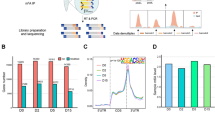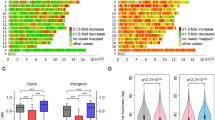Abstract
Transcriptional programming plays a key role in determining the cell state. Timely reconfiguration of chromatin structure and attenuation of pluripotent genes are required for efficient embryonic stem cell (ESC) differentiation. Here, we identify METTL3, a core N6-methyladenosine (m6A) catalyzing enzyme, as a crucial modulator of dynamic transcription and chromatin accessibility upon ESC-derived cardiac differentiation. Genome-wide analysis of chromatin-associated RNAs revealed that depletion of METTL3 failed to dramatically attenuate the transcription of pluripotent genes, as well as activate nascent cardiomyocyte-specific transcripts upon differentiation. Consistently, ATAC-seq analysis showed that loss of METTL3 markedly attenuated the dynamic alteration of chromatin accessibility at both promoters and gene bodies, resulting in reduced sensitivity of ESC chromatin structure to cardiac differentiation signal. Furthermore, we found that METTL3 negatively regulated the histone modifications H3K4me3 and H3K36me3, which are involved in METTL3-modulated dynamic chromatin architecture during cell state transition. Unexpectedly, using chromatin-associated m6A sequencing, we found that nuclear m6A underwent a dramatic increase upon differentiation, which correlates with the decrease of chromatin accessibility. Collectively, our findings reveal that METTL3 and nuclear m6A epitranscriptome couple with chromatin state to ensure transcriptional regulation of cell fate transition.





Similar content being viewed by others
Data availability
The ChrRNA-seq, ATAC-seq, and Chrm6A-seq data generated for this publication have been deposited in NCBI’s Gene Expression Omnibus and are accessible through GEO Series accession number GSE190083. ChIP-seq for histone modifications used in this study has been reanalyzed from published sequencing data (GSE120376).
References
Martello G, Smith A (2014) The nature of embryonic stem cells. Annu Rev Cell Dev Biol 30:647–675. https://doi.org/10.1146/annurev-cellbio-100913-013116
Zhao H, Jin Y (2017) Signaling networks in the control of pluripotency. Curr Opin Genet Dev 46:141–148. https://doi.org/10.1016/j.gde.2017.07.013
Chen CY, Cheng YY, Yen CYT, Hsieh PCH (2017) Mechanisms of pluripotency maintenance in mouse embryonic stem cells. Cell Mol Life Sci 74:1805–1817. https://doi.org/10.1007/s00018-016-2438-0
Schlesinger S, Meshorer E (2019) Open chromatin, epigenetic plasticity, and nuclear organization in pluripotency. Dev Cell 48:135–150. https://doi.org/10.1016/J.DEVCEL.2019.01.003
Yadav T, Quivy J-P, Almouzni G (2018) Chromatin plasticity: a versatile landscape that underlies cell fate and identity. Science (80-) 361:1332–1336
Rando OJ (2007) Global patterns of histone modifications. Curr Opin Genet Dev 17:94–99. https://doi.org/10.1016/j.gde.2007.02.006
Li J, Ahn JH, Wang GG (2019) Understanding histone H3 lysine 36 methylation and its deregulation in disease. Cell Mol Life Sci 76:2899–2916. https://doi.org/10.1007/s00018-019-03144-y
Wei J, He C (2021) Chromatin and transcriptional regulation by reversible RNA methylation. Curr Opin Cell Biol 70:109–115. https://doi.org/10.1016/j.ceb.2020.11.005
Zaccara S, Ries RJ, Jaffrey SR (2019) Reading, writing and erasing mRNA methylation. Nat Rev Mol Cell Biol 20:608–624. https://doi.org/10.1038/s41580-019-0168-5
Shi H, Wei J, He C (2019) Where, when, and how: context-dependent functions of RNA methylation writers, readers, and erasers. Mol Cell 74:640–650. https://doi.org/10.1016/j.molcel.2019.04.025
Patil DP, Chen CK, Pickering BF et al (2016) m6A RNA methylation promotes XIST-mediated transcriptional repression. Nature 537:369–373. https://doi.org/10.1038/nature19342
Ji Q, Zong X, Mao Y, Qian SB (2021) A heat shock–responsive lncRNA heat acts as a HSF1-directed transcriptional brake via m6A modification. Proc Natl Acad Sci U S A 118:1–11. https://doi.org/10.1073/pnas.2102175118
Liu J, Dou X, Chen C et al (2020) N6-methyladenosine of chromosome-associated regulatory RNA regulates chromatin state and transcription. Science (80-) 367:580–586. https://doi.org/10.1126/science.aay6018
Chen C, Liu W, Guo J et al (2021) Nuclear m6A reader YTHDC1 regulates the scaffold function of LINE1 RNA in mouse ESCs and early embryos. Protein Cell 12:455–474. https://doi.org/10.1007/s13238-021-00837-8
Liu J, Gao M, He J et al (2021) The RNA m6A reader YTHDC1 silences retrotransposons and guards ES cell identity. Nature. https://doi.org/10.1038/s41586-021-03313-9
Xu W, Li J, He C et al (2021) METTL3 regulates heterochromatin in mouse embryonic stem cells. Nature. https://doi.org/10.1038/s41586-021-03210-1
Batista PJ, Molinie B, Wang J et al (2014) m6A RNA modification controls cell fate transition in mammalian embryonic stem cells. Cell Stem Cell 15:707–719. https://doi.org/10.1016/j.stem.2014.09.019
Geula S, Moshitch-Moshkovitz S, Dominissini D et al (2015) m6A mRNA methylation facilitates resolution of naïve pluripotency toward differentiation. Science (80-) 347:1002–1006. https://doi.org/10.1126/science.1261417
Zhang T, Cooper S, Brockdorff N (2015) The interplay of histone modifications – writers that read. EMBO Rep 16:1467–1481. https://doi.org/10.15252/embr.201540945
Liu J, Yue Y, Han D et al (2014) A METTL3-METTL14 complex mediates mammalian nuclear RNA N6-adenosine methylation. Nat Chem Biol 10:93–95. https://doi.org/10.1038/nchembio.1432
Fujita J, Tohyama S, Kishino Y et al (2019) Concise review: genetic and epigenetic regulation of cardiac differentiation from human pluripotent stem cells. Stem Cells 37:992–1002. https://doi.org/10.1002/stem.3027
Boland MJ, Nazor KL, Loring JF (2014) Epigenetic regulation of pluripotency and differentiation. Circ Res 115:311–324. https://doi.org/10.1161/CIRCRESAHA.115.301517
Wamstad JA, Alexander JM, Truty RM et al (2012) Dynamic and coordinated epigenetic regulation of developmental transitions in the cardiac lineage. Cell 151:206–220. https://doi.org/10.1016/j.cell.2012.07.035
Kashyap V, Rezende NC, Scotland KB et al (2009) Regulation of stem cell pluripotency and differentiation involves a mutual regulatory circuit of the Nanog, OCT4, and SOX2 pluripotency transcription factors with polycomb repressive complexes and stem cell microRNAs. Stem Cells Dev 18:1093–1108. https://doi.org/10.1089/scd.2009.0113
Young RA (2011) Control of the embryonic stem cell state. Cell 144:940–954. https://doi.org/10.1016/j.cell.2011.01.032
Fong H, Hohenstein KA, Donovan PJ (2008) Regulation of self-renewal and pluripotency by Sox2 in human embryonic stem cells. Stem Cells 26:1931–1938. https://doi.org/10.1634/stemcells.2007-1002
Hough SR, Clements I, Welch PJ, Wiederholt KA (2006) Differentiation of mouse embryonic stem cells after RNA interference-mediated silencing of OCT4 and Nanog. Stem Cells 24:1467–1475. https://doi.org/10.1634/stemcells.2005-0475
Niwa H, Miyazaki JI, Smith AG (2000) Quantitative expression of Oct-3/4 defines differentiation, dedifferentiation or self-renewal of ES cells. Nat Genet 24:372–376. https://doi.org/10.1038/74199
Aguilo F, Zhang F, Sancho A et al (2015) Coordination of m6A mRNA methylation and gene transcription by ZFP217 regulates pluripotency and reprogramming. Cell Stem Cell 17:689–704. https://doi.org/10.1016/J.STEM.2015.09.005
Aguilo F, Walsh MJ (2017) The N6-methyladenosine RNA modification in pluripotency and reprogramming. Curr Opin Genet Dev 46:77–82. https://doi.org/10.1016/j.gde.2017.06.006
Meshorer E, Misteli T (2006) Chromatin in pluripotent embryonic stem cells and differentiation. Nat Rev Mol Cell Biol 7:540–546. https://doi.org/10.1038/nrm1938
Atlasi Y, Stunnenberg HG (2017) The interplay of epigenetic marks during stem cell differentiation and development. Nat Rev Genet 18:643–658. https://doi.org/10.1038/nrg.2017.57
Wu C, Chen W, He J et al (2020) Interplay of m6A and H3K27 trimethylation restrains inflammation during bacterial infection. Sci Adv. https://doi.org/10.1126/sciadv.aba0647
Li Y, Xia L, Tan K et al (2020) N6-methyladenosine co-transcriptionally directs the demethylation of histone H3K9me2. Nat Genet. https://doi.org/10.1038/s41588-020-0677-3
Wang Y, Li Y, Yue M et al (2018) N6-methyladenosine RNA modification regulates embryonic neural stem cell self-renewal through histone modifications. Nat Neurosci 21:195–206. https://doi.org/10.1038/s41593-017-0057-1
Martin M (2011) Cutadapt removes adapter sequences from high-throughput sequencing reads. EMBnet J 17:10–12
Kim D, Paggi JM, Park C et al (2019) Graph-based genome alignment and genotyping with HISAT2 and HISAT-genotype. Nat Biotechnol 37:907–915. https://doi.org/10.1038/s41587-019-0201-4
Langmead B (2010) Aligning short sequencing reads with Bowtie. Curr Protoc Bioinforma. https://doi.org/10.1002/0471250953.bi1107s32
Zhang Y, Liu T, Meyer CA et al (2008) Model-based analysis of ChIP-Seq (MACS). Genome Biol. https://doi.org/10.1186/gb-2008-9-9-r137
Quinlan AR, Hall IM (2010) BEDTools: a flexible suite of utilities for comparing genomic features. Bioinformatics 26:841–842. https://doi.org/10.1093/bioinformatics/btq033
Acknowledgements
The authors are grateful to Howard Y. Chang at Stanford University for kindly providing Mettl3 knockout ES cells, and Roman Spektor at Cornell University for the assistance with ATAC-seq library preparation. They are also grateful to Cornell University Life Sciences Core Laboratory Center for sequencing support.
Funding
This work was supported by US National Institutes of Health (R21CA227917), HHMI Faculty Scholar (55108556), and National Natural Science Foundation of China (32070868, 81974527), as well as Natural Science Foundation of Jiangsu Province, China (BK20211219, BK20190533).
Author information
Authors and Affiliations
Contributions
XML and SBQ conceived the project and wrote the manuscript. XML performed the majority of experiments. YM conducted the majority of data analysis. SW conducted protein blotting and cell differentiation assay with support from JZ. All the authors discussed the results and edited the manuscript.
Corresponding authors
Ethics declarations
Conflict of interest
No conflicts of interest are declared by the authors.
Additional information
Publisher's Note
Springer Nature remains neutral with regard to jurisdictional claims in published maps and institutional affiliations.
Supplementary Information
Below is the link to the electronic supplementary material.
Rights and permissions
Springer Nature or its licensor (e.g. a society or other partner) holds exclusive rights to this article under a publishing agreement with the author(s) or other rightsholder(s); author self-archiving of the accepted manuscript version of this article is solely governed by the terms of such publishing agreement and applicable law.
About this article
Cite this article
Liu, XM., Mao, Y., Wang, S. et al. METTL3 modulates chromatin and transcription dynamics during cell fate transition. Cell. Mol. Life Sci. 79, 559 (2022). https://doi.org/10.1007/s00018-022-04590-x
Received:
Revised:
Accepted:
Published:
DOI: https://doi.org/10.1007/s00018-022-04590-x




